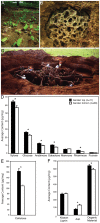An insect herbivore microbiome with high plant biomass-degrading capacity
- PMID: 20885794
- PMCID: PMC2944797
- DOI: 10.1371/journal.pgen.1001129
An insect herbivore microbiome with high plant biomass-degrading capacity
Abstract
Herbivores can gain indirect access to recalcitrant carbon present in plant cell walls through symbiotic associations with lignocellulolytic microbes. A paradigmatic example is the leaf-cutter ant (Tribe: Attini), which uses fresh leaves to cultivate a fungus for food in specialized gardens. Using a combination of sugar composition analyses, metagenomics, and whole-genome sequencing, we reveal that the fungus garden microbiome of leaf-cutter ants is composed of a diverse community of bacteria with high plant biomass-degrading capacity. Comparison of this microbiome's predicted carbohydrate-degrading enzyme profile with other metagenomes shows closest similarity to the bovine rumen, indicating evolutionary convergence of plant biomass degrading potential between two important herbivorous animals. Genomic and physiological characterization of two dominant bacteria in the fungus garden microbiome provides evidence of their capacity to degrade cellulose. Given the recent interest in cellulosic biofuels, understanding how large-scale and rapid plant biomass degradation occurs in a highly evolved insect herbivore is of particular relevance for bioenergy.
Conflict of interest statement
The authors have declared that no competing interests exist.
Figures




References
-
- Sticklen MB. Plant genetic engineering for biofuel production: towards affordable cellulosic ethanol. Nat Rev Genet. 2008;9:433–443. - PubMed
-
- Warnecke F, Luginbuhl P, Ivanova N, Ghassemian M, Richardson TH, et al. Metagenomic and functional analysis of hindgut microbiota of a wood-feeding higher termite. Nature. 2007;450:560–565. - PubMed
-
- Turnbaugh PJ, Ley RE, Mahowald MA, Magrini V, Mardis ER, et al. An obesity-associated gut microbiome with increased capacity for energy harvest. Nature. 2006;444:1027–1031. - PubMed
Publication types
MeSH terms
Substances
Associated data
- Actions
LinkOut - more resources
Full Text Sources
Other Literature Sources
Medical
Molecular Biology Databases

